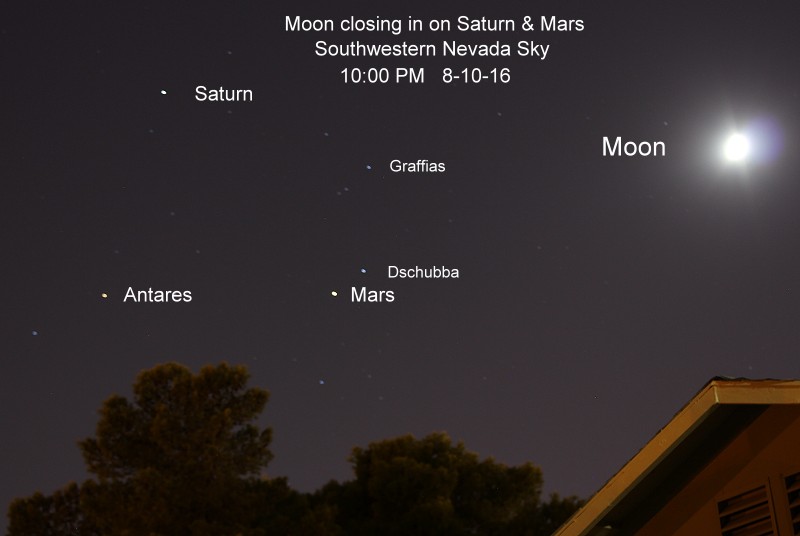Tonight – August 12, 2016 – use the waxing gibbous moon to find the ringed planet Saturn and nearby red planet Mars. Or maybe you noticed them already while watching meteors in the Perseid meteor shower these past few nights. The meteor shower is probably past its peak now, but – although the Perseid shower tends to rise to a peak gradually and then fall off rapidly after its peak – you should still be able to see some meteors in a dark sky between midnight and dawn Saturday morning. Meanwhile, Friday evening, watch for the moon and planets. Mars is the brighter of the two planets near the August 12 moon, while Saturn shines more brilliantly than nearby Antares, the brightest star in the constellation Scorpius the Scorpion.
These colorful celestial beauties – Saturn, Mars and Antares, brightest star in Scorpius the Scorpion – form a triangle of lights that you can see in the evening sky.
Can you still see meteors? Yes! Click here for photos and more info.
These next two photos, from Bob Kelley near Las Vegas Nevada, show how the moon has moved eastward, past the planets, over these past two nights.


Keep watching Mars and Saturn, even after the moon moves away. With the star Antares, these planets have made a prominent triangle on our sky’s dome for many months. But Mars is on the move now, in front of the star background. Mars is rapidly traveling eastward in the direction of Saturn and Antares. It’ll pass in between Saturn and Antares on or near August 24.
On August 24, Saturn and Mars to be in conjunction (north and south of one another on the sky’s dome). Saturn, Mars and Antares will align on the sky’s dome. Saturn will mark the northern point and Antares the southern point of this celestial line-up, with Mars to the south of Saturn and to the north of Antares.
After the Mars-Saturn conjunction on August 24, be sure to keep an eye on Saturn, Mars and Antares as darkness falls in the following months.
You’ll see the red planet Mars travel farther and farther east of Saturn and Antares day by day.

Bottom line: On August 12, 2016, the peak of the Perseid meteor shower has probably passed, but you can still see meteors in a dark sky in the hours before dawn. Also, on August 12, use the moon to locate a triangle of objects: Saturn, Mars and Antares. By late August and September, Mars will have moved to the other side of Saturn and Antares, to mark the easternmost point of this changing celestial triangle.











